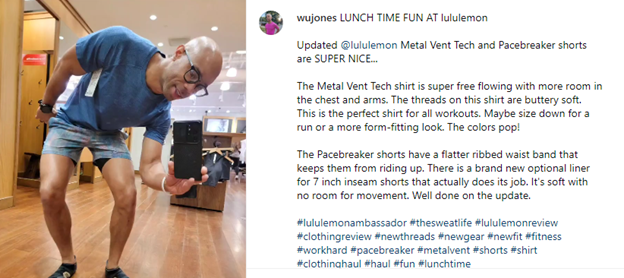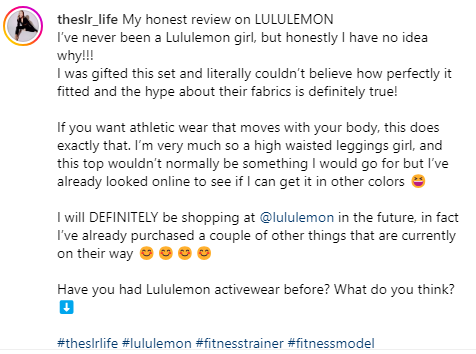Every business has that golden guild of fans, and lululemon is no different. They’ve mastered the art of understanding their target audience – those high-income earners who are obsessed with fitness and projecting an aura of effortless success.
Ever walked into a lululemon store? It’s like stepping into a parallel universe where everyone’s ridiculously good-looking, zen, and smells faintly of grapefruit and ambition.
But how did those stretchy pants turn into a billion-dollar empire? Easy. lululemon gets you.
lululemon started back in 1998 intending to banish see-through yoga pants for good, just as yoga hopped onto Canada’s trend wagon.
Over the years, the brand has expanded beyond the retailing of yoga wear to include other athletic and leisure wear. They have also expanded their geographic market beyond Canada to other parts of the world including the United States, United Kingdom, China, Australia, South Korea, and many others.
lululemon’s target market was initially restricted to yogis, but, the brand’s expansion into the retailing of other athleisure apparel which catered to runners, cyclists, tennis players, and swimmers expanded its target market.

Think of it as a bullseye. Your ideal customers. Your die-hard fans. The ones on who you focus your products, services, and marketing strategies. The people who will line up to buy your stuff without blinking twice.
A target market is also referred to as a serviceable obtainable market (SOM). It’s a subset of the bigger market. It might be about gender, income, age, or whatever floats that group’s boat.
Example? If you sell baby formula, hit up the moms! They make the feeding calls at home.
Businesses generally tailor their marketing efforts with the expectations and needs of their customer demography in mind.
For instance, when marketing organic foods, retailers often focus on consumer’s need to access healthier food items to enhance their pursuit of a healthy lifestyle.
When a business has more than one consumer segment to which it caters, the consumers will be divided into primary and secondary target markets.
For lululemon, their primary audience? Our dear yogis. But they’ve got secondary groups too – men and women who run, hike, or just want to look fly in some comfy wear.
Still scratching your head about target markets? Check out this comprehensive guide on target market identification. Get your Aha! Moment!
So, who’s in this clique? Men and women living their best active lives. Health nuts who splash cash on looking and feeling great. lululemon uses different marketing strategies and the marketing mix to reach its target consumers.
lululemon don’t just sell gear; they build teams. Their community game is on point – engaging athletes, trainers, and influencers to hype the brand. Real people giving real feedback on consumer experience and expectations about the brand’s products.
And those store associates? They’re “educators”. Not your average retail troops. They are valuable contributors in helping the brand better understand the needs of its consumer base through the feedback they receive from shoppers.
lululemon does in-depth research on the best fabrics and designs that will provide maximum support to its consumers through its experts in Whitespace; yap! That’s where lululemon’s R&D team whips up all the magic.
These fabric and design whizzes cook up the next big thing in activewear. The in-depth research provides them with deeper insights into how the brand’s fabrics and designs combine with its customer’s physiology to support an active lifestyle.
Due to their effective research, the brand gets why people buy, how much they’d stretch their purse strings, and what makes them tick.
Did you know that once upon a time, children between 6 – 12 years were part of lululemon’s target market? Surprised right? Let me share the tea.
lululemon ventured into children’s apparel through ivivva athlethica in 2009, they stole the hearts of many kids and parents through dedicated children’s stores but it seemed like they weren’t raking in enough dollars so they scaled back on ivivva stores in 2017 and focused more on online sales. Unfortunately, it seemed like scaling back was still not as profitable as they hoped so they shut everything down in the first quarter of 2020. Tough market!
Let’s be real, lululemon isn’t for everyone. And that’s precisely how they built their brand. Their target consumer is as specific as their price tags.

Demographics: Think millennials and Gen Xers, predominantly women, with disposable income (we’re talking at least $100 for yoga pants kind of disposable). They’re educated, health-conscious, and value experiences over material possessions (except, of course, those pricey leggings).
Psychographics: These folks are all about that aspirational lifestyle. They’re driven, ambitious, and love the feeling of being part of a community. They prioritize fitness, wellness, and self-improvement. They’re the type of people who’d actually enjoy a 6 am yoga class.
When lululemon was established in 1998, it was inspired by the founder’s discovery of a gap in the yoga wear industry. He noticed that the pants women used for yoga were too thin and became sheer when a person bent over or did some particular poses; guilty as charged downward dog.
Guess why yogis had this problem? Yoga pants weren’t a thing then so yogis had to make do with pants for dancers. Oops!
And what did Chip Wilson do? After noticing the gap, he got talking with some yoga instructors to understand what they wanted their pants to be like. Armed with that information, he got to work with a team of researchers to create yoga pants that were high-quality, thicker, anti-stink, moisture-wicking, and comfortable.
That my friend, is how lululemon came about; establishing itself as the go-to brand for all things yoga. Go Chip!
So, what kind of woman falls into the target market of lululemon? A super girl called Ocean. Don’t fret, I’ll break it down.
Ocean is a woman in her 30s or 40s with sufficient disposable income who cares about keeping fit and is willing to pay any amount for the right apparel to pursue an active lifestyle.
Now you know why those leggings are premiumly priced!
The quality and fashionable design of lululemon products have created a seamless merging of clothes for athletics and leisure. Little wonder every Ocean can comfortably wear her yoga wear outside the yoga studio and still look fashionable. Fashion meets function. Luluwear for yoga and brunch. Winning!
lululemon knows a good thing when they see it and are not afraid to expand their reach. They strategically diversified their into men’s wear in 2014. Although the brand had expanded beyond yoga pants to include self-care products, accessories, and shirts long before 2014, it was still largely perceived as a women’s brand.
The production of male wear by lululemon was like a neon sign, saying, we care about men’s clothing needs too by providing them with high-quality, stylish, and functional pieces that make them feel like a million bucks.
What’s the male target customer of lululemon like? Meet Duke:
Age: 35
Annual Income: $100K+
Winter hobby: Snowboarding
Summer vibe: Surfing.
Duke is Ocean’s male counterpart and just as swanky. Active lifestyle? Check. Earns a good income? Check. Can afford premium athleisure wear? Double-check
Forbes reports that lululemon’s men’s segment has grown steadily (even more than the women’s segment) since it began, indicating that men love the feel of lululemon on their skin.

Attracting customers is one thing, maintaining them is another. Simultaneously attracting new customers and maintaining old ones is a stuff for geniuses.
At attracting and retaining customers, lululemon is what Gandalf is to magic and hobbits. Legendary! lululemon’s revenue keeps climbing, proving their knack for keeping loyal fans and snagging new ones.
lululemon’s target market can be further divided into several categories:
So, how does lululemon attract and maintain this diverse group of consumers?
lululemon’s micro-influencers and brand ambassadors preach the lululemon gospel in their communities, encouraging them to patronize the brand. Store-based and community events or initiatives such as Strength to Be keep the love alive.
Social media buzz? Real people sharing their experiences using lulu products; #lululemon #lululemonreviews #sweatlife

lululemon apparel and accessories are designed not only for performance during rigorous workouts but also have an aesthetic appeal; stylish for work and play. Check the ABC pants – work-appropriate but oh-so-lululemon.
IDEA (Inclusion, Diversity, Equity, and Action) matters here. The brand is committed to creating opportunities for a diverse workforce, producing for the same, and taking action through increased funding to reduce marginalization.
Through the brand’s strategic partnership with diverse companies such as Genomatica, LanzaTech, and Mylo, lululemon produces alternative raw materials for its products. The Like New Initiative also creates a circular economy by ensuring that more people access lululemon products at a reduced rate while reducing the amount of products that would have otherwise ended up in landfills.
With relentless innovation, lululemon’s fit-tastic designs stay fresh, ensuring that customers never run out of novel designs for either athletics or leisure.
By focusing their products on meeting specific consumer demands such as feeling snatched in their yoga pants or having bras that feel like being naked, lululemon keeps the customers hooked.
What’s your one thing? As a newbie in the industry, being known for one thing should be your default tactic. When lululemon was the new kid on the block, they focused on their primary target market; female yogis. They did this so well that the brand became synonymous with high-quality yoga pants.
Who are your people? Get really, really specific about who your ideal customer is. What makes them tick? What are their pain points? What do they aspire to?
Don’t be afraid to niche down: It’s better to be loved by a few than forgotten by many. Focus on serving a specific audience exceptionally well.
Build a community, not just a customer base: Create opportunities for your customers to connect with each other and your brand. Host events, start a forum, or get active on social media.
Price for value: Don’t be afraid to charge a premium for your products or services if you’re delivering exceptional quality and value.
Expand: As lululemon grew and gained brand recognition, it took strategic steps by evolving into a gender-neutral brand catering to both males and females. It equally evolved beyond being a Canadian brand to becoming a global retailer of athleisure products.
So, start with one thing and do it damn well, then, grow, evolve, and add new fans. Scale from a niche brand to a global force. And hey, don’t box yourself in. Aim high, break boundaries, and be the lululemon of your industry!

Email subscription is available ONLY TODAY (oh, okay, and tomorrow).
Surely, we respect your inbox! Unsubscription works every day.

We’d love to tailor your experience — which of these best describes you?